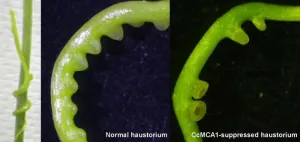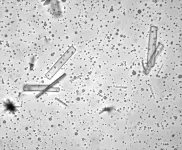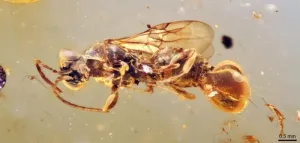(Press-News.org) In the past, intact forests absorbed 7.8 billion tonnes of CO₂ annually – about a fifth of all human emissions – but their carbon storage is increasingly at risk from climate change and human activities such as deforestation. A new study from the Potsdam Institute for Climate Impact Research (PIK) shows that failing to account for the potentially decreasing ability of forests to absorb CO₂ could make reaching the Paris agreement targets significantly harder, if not impossible, and much more costly.
“Delaying action leads to disproportionately higher costs,” explains Michael Windisch, lead author of the study published in Nature Communications and PIK guest scientist. “Right now, our climate strategies bet on forests not only remaining intact, but even expanding,” Windisch says. “However, with escalating wildfires like in California, and continued deforestation in the Amazon, that’s a gamble. Climate change itself puts forests’ immense carbon stores at risk.” According to the study, postponing action to reduce emissions and to protect and monitor forests could jeopardise climate targets. “We must act immediately to safeguard the carbon stored in forests,” Windisch emphasises. “Otherwise, compensating for potential forest carbon losses through steeper emissions cuts in key emission sectors like energy, industry and transport will become increasingly expensive and possibly unattainable.”
Considering forest carbon losses in climate mitigation pathways
The study analysed how climate targets can be met despite forests’ reduced capacity for storing carbon. The authors used REMIND-MAgPIE - an integrated global land and water use modelling as well as an energy-economy modelling system - together with the global vegetation model LPJmL to evaluate how natural disturbances and human impacts on forests influence the feasibility of achieving climate mitigation goals. The research team compared a foresighted policy response with various delayed and myopic approaches.
Regardless of the assessed disturbance rate, the study revealed just how steep the price of inaction can be. Even a five-year delay in responding to forest carbon loss would lead to a roughly two-fold increase in both the stringency and overall cost of measures to offset that lost carbon, the authors find. Emission cuts in the energy sector, for instance, would have to be ramped up considerably, supported by a near-doubling of negative emissions capacity – which itself demands a corresponding expansion in land use. Ultimately, these extra efforts drive up overall costs, and result in GDP setbacks that are approximately double those of immediate action.
The study also highlights that current models may be overly optimistic about future forest carbon storage because they ignore disturbances, overvalue CO₂ fertilisation and underestimate deforestation. To mitigate climate impacts, safeguard carbon stocks and prevent escalating costs, the scientists recommend immediate action. “Forests are not an infinite resource, but need careful monitoring to detect reductions in carbon sinks early on,” explains Florian Humpenöder, PIK scientist and study author. He also stresses the need for stronger forest conservation, and faster decarbonisation. Forests may absorb less CO2 than expected, making realistic forest carbon projections essential.
“Staying below critical warming thresholds requires more than just hoping forests will remain intact,” concludes Alexander Popp, head of PIK’s Land Use Transition lab and author of the study. “Alongside protecting forests, it is essential to promote sustainable land use practices– not only to preserve biodiversity but also to avoid drastic economic consequences and to secure our climate future.”
Article: Michael G. Windisch, Florian Humpenöder, Leon Merfort, Nico Bauer, Gunnar Luderer, Jan Philipp Dietrich, Jens Heinke, Christoph Müller, Gabriel Abrahao, Hermann Lotze-Campen, Alexander Popp (2025): Hedging our bet on forest permanence for the economic viability of climate targets. Nature Communications. DOI: [10.1038/s41467-025-57607-x]
Weblink to the article, once published: https://www.nature.com/articles/s41467-025-57607-x
END
Losing forest carbon stocks could put climate goals out of reach
2025-03-27
ELSE PRESS RELEASES FROM THIS DATE:
From weight to wellness: New database transforms obesity research
2025-03-27
A new medical database automatically compiles the medical records of obese patients and those suffering from obesity-related diseases in a uniquely comprehensive and reliable manner. The initiative, led by Kobe University, offers valuable insights for health promotion and drug development.
“Obesity is at the root of many diseases,” says OGAWA Wataru, an endocrinologist at Kobe University. Obesity has been linked to the development of diabetes, hypertension, gout, coronary heart disease, stroke and many other diseases. Monitoring, treating and preventing obesity and the diseases it can cause is therefore not only good for ...
Nature’s viny vampire: Discovering what drives parasitic Cuscuta campestris
2025-03-27
The parasitic vine Cuscuta campestris grows by latching onto the stems and leaves of plants and inserting organs called haustorium into the host plant tissues to draw nutrients. The haustorium is formed when ion channels in the cell membrane are stimulated during coiling and induce a reaction within the cell.
Further, Cuscuta campestris has many types of ion channels, but which ones were linked to the development of haustorium were previously unknown.
“For the first time, the genes involved in sensing ...
How calcium may have unlocked the origins of life’s molecular asymmetry
2025-03-27
A new study led by researchers at the Earth-Life Science Institute (ELSI) at Institute of Science Tokyo has uncovered a surprising role for calcium in shaping life’s earliest molecular structures. Their findings suggest that calcium ions can selectively influence how primitive polymers form, shedding light on a long-standing mystery: how life’s molecules came to prefer a single “handedness” (chirality).
Like our left and right hands, many molecules exist in two mirror-image forms. Yet life on Earth has a striking preference: ...
Study finds long Covid patients feel pressure to prove their illness is real
2025-03-27
People living with Long Covid often feel dismissed, disbelieved and unsupported by their healthcare providers, according to a new study from the University of Surrey.
The study, which was published in the Journal of Health Psychology, looked at how patients with Long Covid experience their illness. The study found that many patients feel they have to prove their illness is physical to be taken seriously and, as a result, often reject psychological support, fearing it implies their symptoms are "all in the mind".
Professor ...
Smartwatches may help control diabetes through exercise
2025-03-27
Wearable mobile health technology could help people with Type 2 Diabetes (T2D) to stick to exercise regimes that help them to keep the condition under control, a new study reveals.
Researchers studied the behaviour of recently-diagnosed T2D patients in Canada and the UK as they followed a home-based physical activity programme – some of whom wore a smartwatch paired with a health app on their smartphone.
They discovered that MOTIVATE-T2D participants were more likely to start and maintain purposeful exercise at if they had the support of wearable technology- the study successfully recruited 125 participants with an 82% ...
Fossils: Ancient parasitic ‘Venus flytrap’ wasp preserved in amber
2025-03-27
An extinct lineage of parasitic wasps dating from the mid-Cretaceous period and preserved in amber may have used their Venus flytrap-like abdomen to capture and immobilise their prey. Research, published in BMC Biology, finds that the specimens of Sirenobethylus charybdis — named for the sea monster in Greek mythology which swallowed and disgorged water three times a day — date from almost 99 million years ago and may represent a new family of insects.
The morphology of S. charybdis indicates the wasps were ...
New species revealed after 25 years of study on ‘inside out’ fossil – and named after discoverer’s mum
2025-03-27
A new species of fossil from 444 million years ago that has perfectly preserved insides has been affectionately named ‘Sue’ after its discoverer’s mum.
The result of 25 years of work by a University of Leicester palaeontologist and published in the journal Palaeontology, the study details a new species of multisegmented fossil and is now officially named as Keurbos susanae.
Lead author Professor Sarah Gabbott from the School of Geography, Geology and the Environment said: “‘Sue’ is an inside-out, legless, headless wonder. Remarkably her insides are a mineralised ...
THE LANCET HIV: Proposed cuts to foreign aid could result in millions of HIV deaths and soaring rates of global HIV infections, new modelling study estimates
2025-03-27
New modelling analysis suggests that proposed funding cuts by major donor countries to foreign aid could undo decades of progress made to end HIV/AIDS as a public health threat and new infections and deaths could surge back to levels not seen since the early 2000s.
The study estimates there could be between 4.4 million to 10.8 million additional new HIV infections by 2030 in low-and-middle income countries (LMICs) and between 770,000 to 2.9 million HIV-related deaths in children and adults by 2030.
The greatest impact from potential funding ...
Study reveals association between dietary sodium consumption and both general and abdominal obesity
2025-03-26
New research to be presented at this year’s European Congress on Obesity (ECO 2025, Malaga, Spain, 11-14 May) shows an association between the amount of sodium consumed in the diet and the risk of both general and abdominal obesity. The study is by Annika Santalahti, Finnish Institute for Health and Welfare, Helsinki, Finland, and colleagues.
General obesity is a person’s obesity status as measured by their body mass index (BMI), with WHO international guidelines stating a BMI of 30 kg/m2 or more means a person is living with obesity. Abdominal obesity is where fat accumulates around the abdomen and internal organs there, leading ...
Study finds knowledge of genetics and genomic medicine crucial for mental health providers to deliver informed, personalized care
2025-03-26
San Diego—March 26, 2025– In a manuscript published today in the American Journal of Psychiatry titled Psychiatric Genetics in Clinical Practice: Essential Knowledge for Mental Health Professionals, authors provide updated guidelines on what mental health professionals should know about the latest advances in genetics and how genetics can inform clinical psychiatric practice.
Key findings highlight the importance of understanding the genetic architecture of psychiatric disorders, the potential applications of genetic information in risk assessment, diagnosis, treatment selection, and patient education, ...




